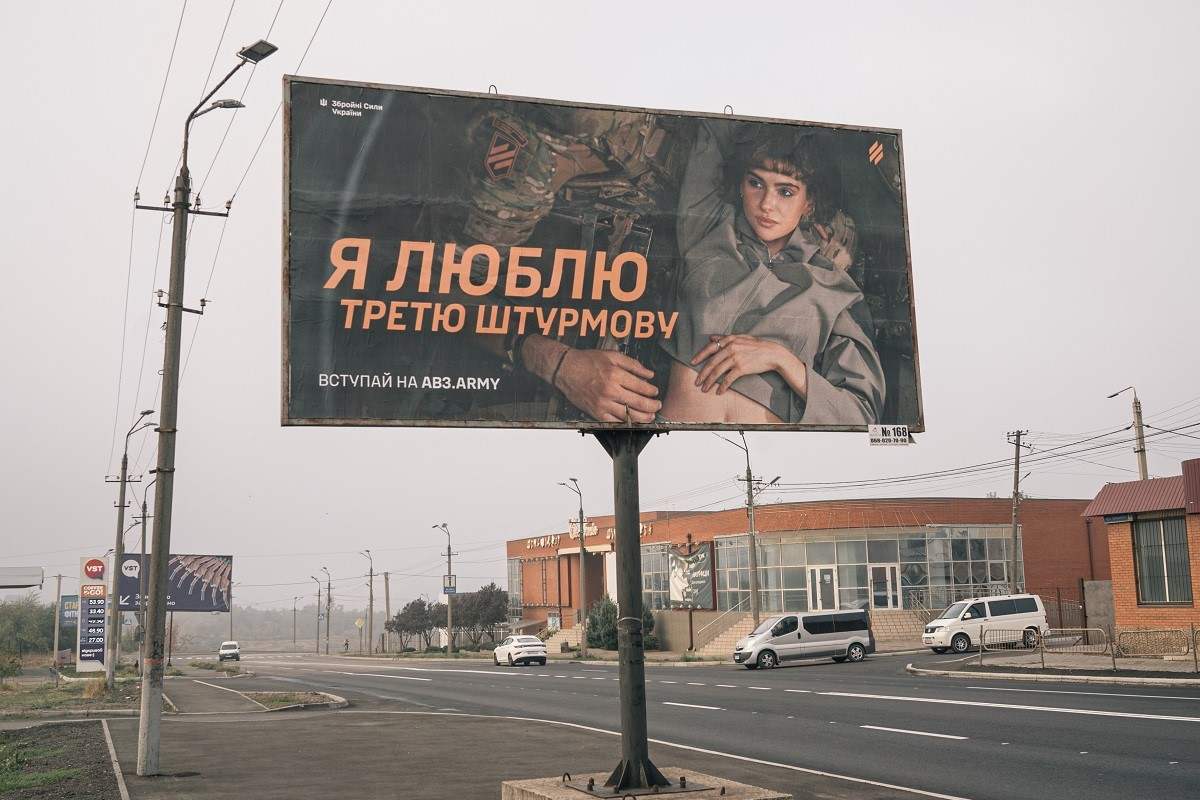
One of the new recruitment campaign billboards for 3rd Assault Brigade on the side of a road in the Mykolaiv region.
15:35 JST, October 15, 2024
KYIV – The machine-gunner gripped his weapon – body taut, eyes focused, finger on the trigger.
Atop the hood of his Humvee, a model in cutoff shorts and cherry-red stilettos leaned back on her elbows, bare legs dripping with bubbles. The soldier took aim with his weapon – a power-washer.
Cameras flashed.
This was no battlefield, but the front lines of the Ukrainian 3rd Assault Brigade’s next advertising campaign – a modern take on World War II-style pinup girls, complete with scantily clad models gripping pistols and straddling soldiers. The brigade hopes this campaign will attract recruits, who are increasingly in short supply as the war with Russia drags toward its third year.
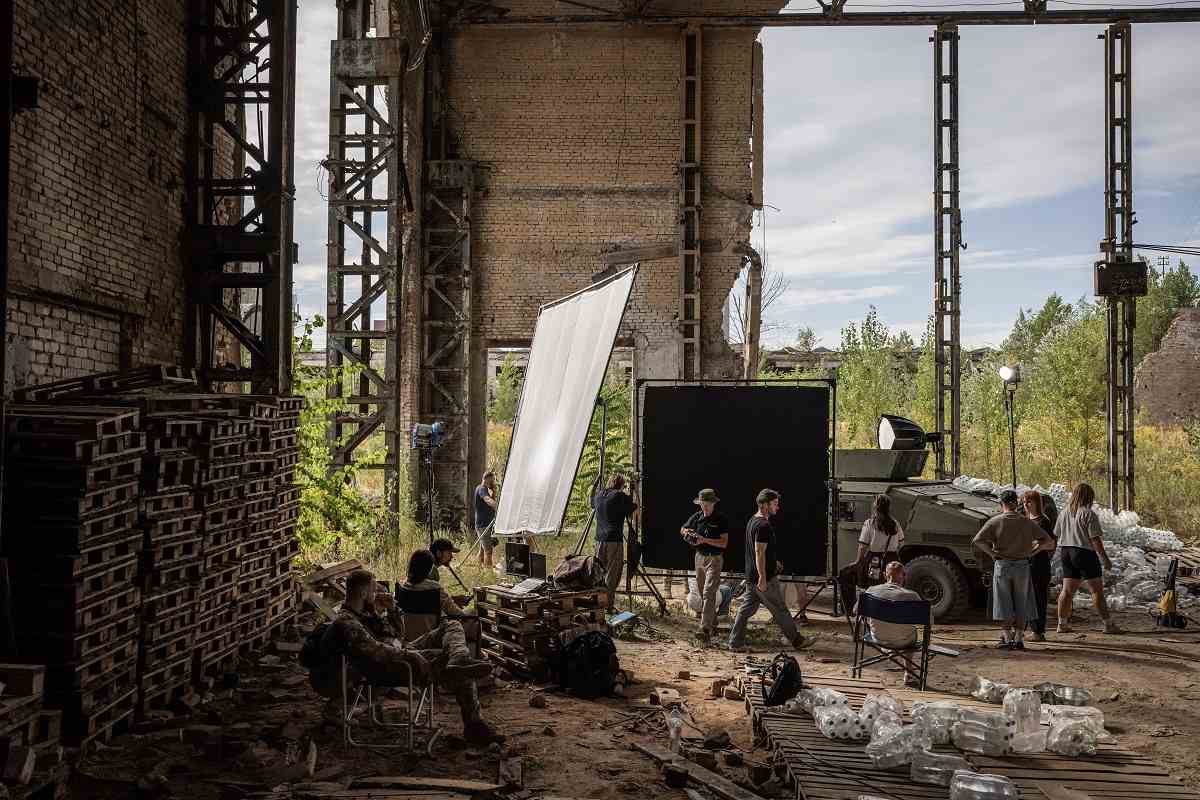
Models, photographers and military personnel work on the set of a shoot for the 3rd Assault Brigade’s next military recruitment campaign in Kyiv on Aug. 31.
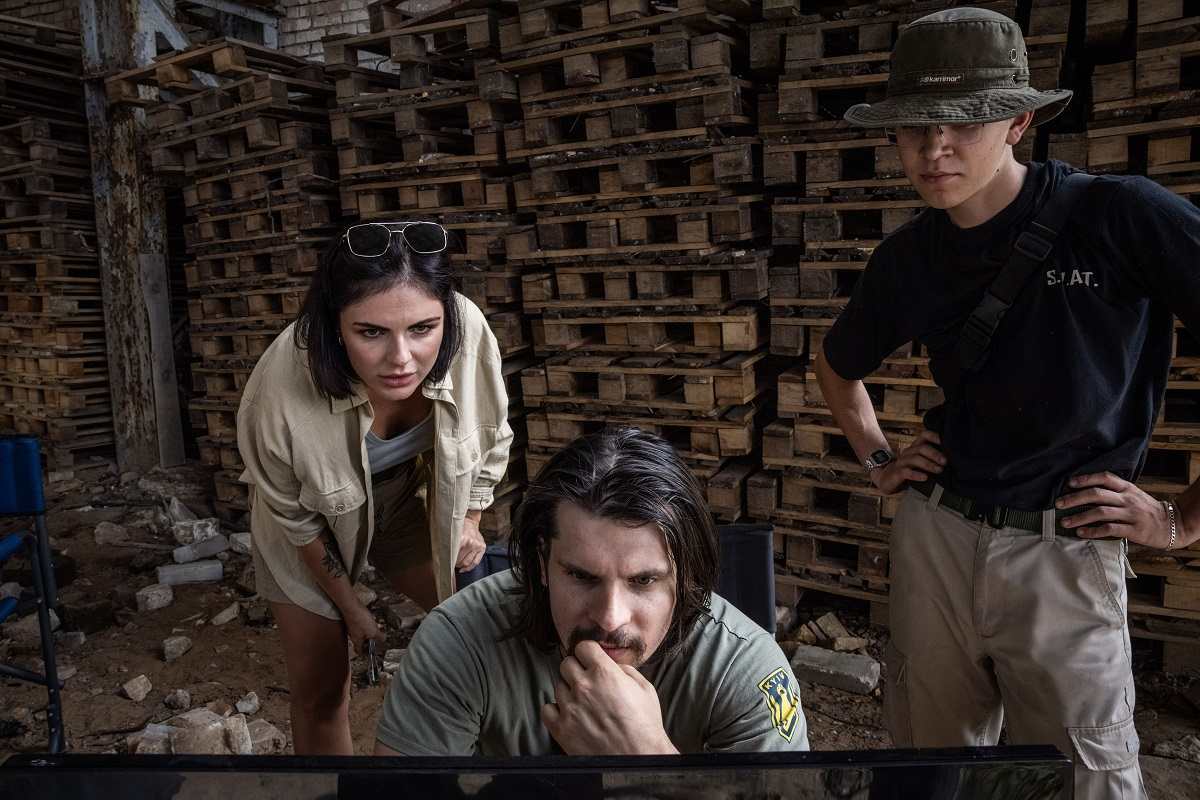
Khrystyna Bondarenko, head of the 3rd Assault Brigade’s marketing team, art director Vlad Kulyk and a photographer review images taken for the brigade’s next military recruitment campaign in Kyiv.
With the public having grown leery of draft efforts, military units across Ukraine are competing with each other to refill their depleted ranks. To better fight the war, they have to sell it, and few do it better than the 3rd Assault brigade, known for its innovative billboards and dollar-generating YouTube channel, as well as the controversial ideology of its founder.
Unique to Ukraine is the fact that its military’s more than 130 brigades are now allowed to directly seek out recruits – avoiding the national draft centers altogether. The 3rd Assault Brigade has taken the approach of appealing to ordinary citizens and showing them the kind of soldier they would be if they volunteered for Ukraine’s “top fighting unit.”
“This is a modern war that requires us to be more open,” said media team commander Khrystyna Bondarenko in the brigade’s first interview about its advertising process. “We need to commercialize and sell the idea that it is cool to be in the army.”
At the photo shoot, she and two other members of the 20-person creative team perched on canvas director’s chairs in front of a computer screen, previewing the day’s images. In one shot, a soldier’s profile is reflected in the sunglasses of a pretty redhead, her bangs lightly curled. In another, a model in a pleated schoolgirl skirt is draped across a soldier’s lap in the back of a Humvee.
The brigade expects this campaign to drum up controversy – but it hopes the attention will work in its favor.
‘Come join’
Military advertisements blanket Ukraine, along highways and city streets and all across social media, marketing different versions of warfare – some placid and devoid of violence, others patriotic and valorous.
The 93rd Mechanized Brigade asserts that “Everyone can do it!” with photos of ordinary civilians on the battlefield – the tractor driver behind the wheel of a tank, the professional chef whipping up meals on the front lines. The 13th Operational Brigade of Khartia reassures that not all jobs are combat, superimposing the message, “Your brain, your weapon,” on a picture of a man wearing glasses and sitting at a computer.
The Offensive Guard takes a different tack, proclaiming, “First at the border, first in the attack,” with an image of a clean-shaven soldier white-knuckling a weapon, ammunition filling the pockets of his tan flak jacket.
The effectiveness of these efforts is unknown. The military does not release data about the number of voluntary recruits, deeming those numbers sensitive information. But recruitment appears to be sagging as Ukraine continues to be out-resourced by more populous Russia.
Last year, Ukraine set up a new training center, hoping to alleviate public unease over the military’s ability to properly train and outfit new soldiers. Recruitment centers are also sprinkled across the country to “build a transparent and effective model of attracting citizens to military service,” according to the website of the Ministry of Defense, which did not respond to calls for comment.
The 3rd Assault Brigade became known for its intensive fighting during the battle for Bakhmut, which destroyed the city, and more recently in clashes east of Kharkiv. Its founder, Andriy Biletsky, was a far-right politician before the war.
The brigade took the lead in appealing directly to citizens. It offers a no-commitment test week when normal people can try out being soldiers, wearing military uniforms and engaging in physical challenges, as well as an intensive 30-day training program for recruits.
Its efforts have spurred other brigades to innovate in similar ways.
“It’s only through healthy competition that we produce a good and high-quality product,” said Buriak Ivan, chief sergeant of the 93rd Mechanized Brigade. “We see them as a kind of competitor. We try to raise our own standards. … We pay attention to them, just as they pay attention to us.”
‘Creating an image’
The first of the 3rd Assault Brigade’s campaigns ran in March 2023 and featured five of the elite unit’s commanders.
Though skeptical, the men agreed to take a break from fighting and pose near the front lines, the photo shoot taking place in the basement of a factory. Rather than conceal their faces behind balaclavas, as is traditionally done, they bared them to the world. The message – an attempt at trust and transparency – was “come join.”
The campaign helped generate 150 to 200 daily applications, Bondarenko said. While only about 1 in 10 applications ended in enlistment, she saw it as a success.
“We believe we are creating an image, and we are trying to get people to stand by that image,” said the brigade’s art director, Vlad Kulyk, who formerly worked in marketing. “We rally the people who fully believe it is possible to end this war as soon as possible.”
Their second campaign portrayed soldiers facing off against their Russian adversaries – who were depicted as zombies. The landscape surrounding them is washed by sunset oranges and reds.
Their third campaign struck a lighter note and showed recruits seated in lawn chairs, flying drones against a blue summer sky. For the most recent campaign, they wanted to experiment with entirely new imagery while tying into historical themes.
They settled on pinup girls.
“We wanted to bring some sort of light mood,” said chief designer Dmytro, who asked to be identified by only his first name because of the sensitivity of his job in the military. “People think it’s some kind of trick to drag you into the brigade and give you a bayonet and fight in the trenches. We wanted to say, like, war is not always blood and death or guys fighting. Sometimes you just chill and learn.”
The creative work, Bondarenko said, is done by a team of 20 – 13 military personnel and seven civilians. Their messaging feels impossible to escape, covering more than 1,000 billboards across Ukraine, which she said are largely donated. Digital ads are funded by the profits from their YouTube channel, she said, which has nearly 1.3 million subscribers and generates more than $15,000 monthly. On Instagram, they have another 115,000 subscribers.
Soon, they hope to expand into a new area – merchandising. The brigade envisions it as a one-stop shop where people can purchase T-shirts, patches and other mementos of the war.
‘Balance’
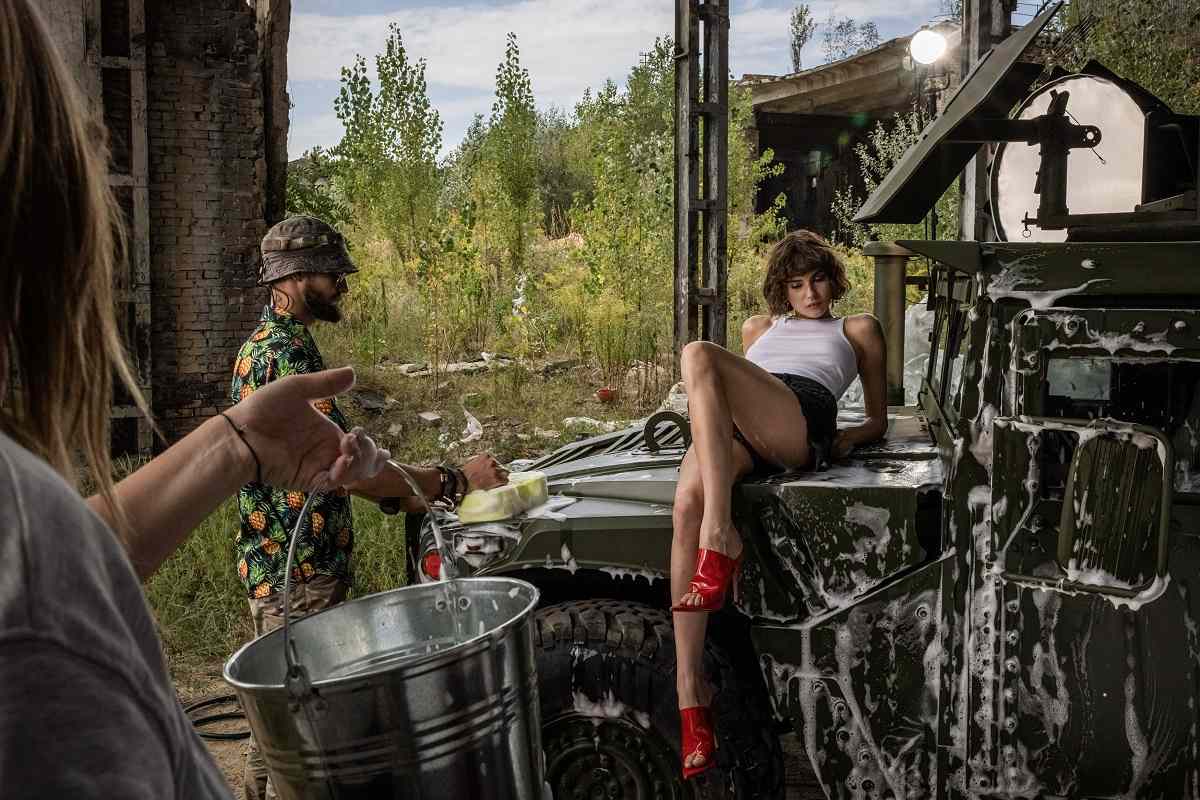
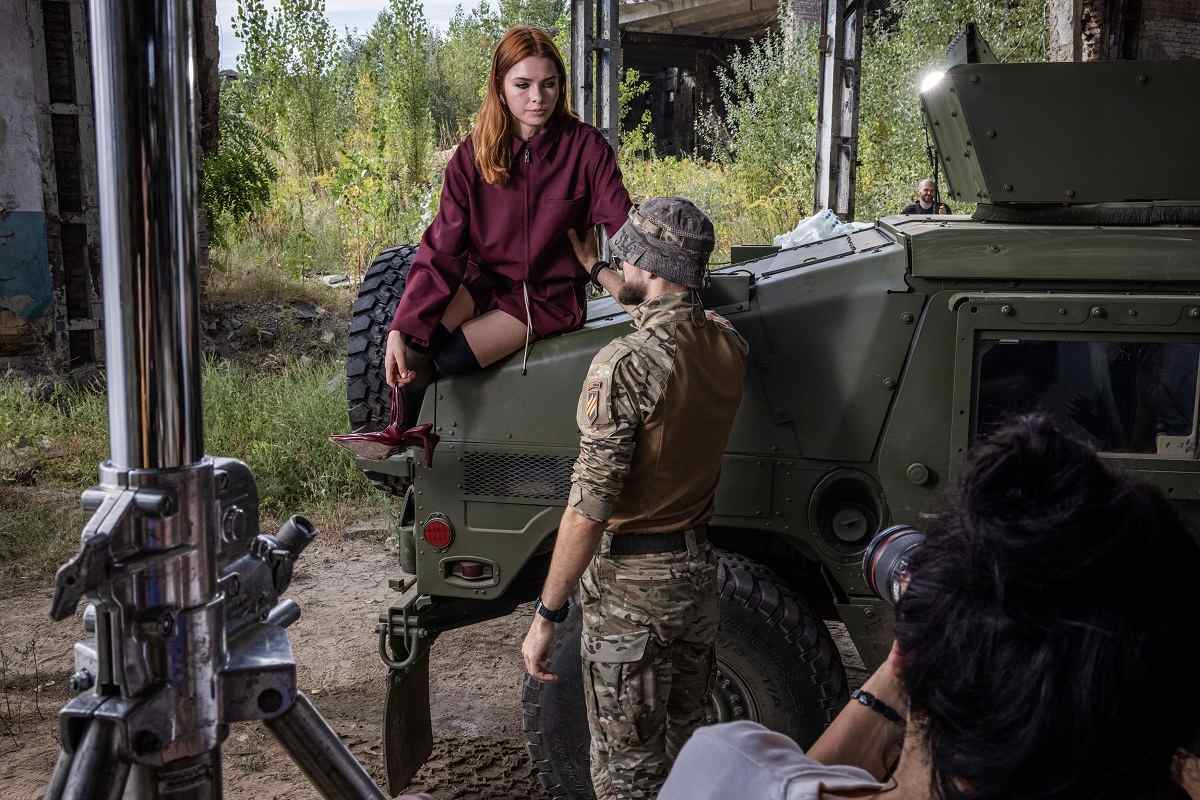
Model Maria, 25,(Top) and Arina, 20,(Bottom) are photographed on Aug. 31 on the hood of a Humvee for the 3rd Assault Brigade’s next military recruitment campaign in Kyiv.
On set, the soldier swiped a yellow sponge across the military vehicle’s hood in tight, precise circles. The model again reclined, silver crosses dangling from her ears.
The professional photo shoot was a first for the soldier – gravely injured in Bakhmut and again in Avdiivka, he was back in Kyiv recovering. He would soon return to combat, along with the Humvee. Though the afternoon’s activities would suggest otherwise, he and the creative team know the product they are selling is more serious than the campaign might suggest.
“Yes, war is terrible,” said Kulyk. “We are not romanticizing that you will kill the enemy – but we romanticize that you will have good memories after the war. You will have friendships, you will have connections, you will have a lot. We have to balance it.”
They would also have, he hoped, a victory.
After a few more rounds of photos, the soldier dropped his sponge, damp with soapy water. They moved on to the next portion of the photo shoot before calling it a day.
By early October, the advertisements were popping up across Ukraine to mixed reviews. One X user called it “cringeworthy,” adding: “I seriously want to look into the eyes of the person who came up with this idea.” On Facebook, a woman posted a photo of a billboard on the highway with the caption: “I love the Third Assault Brigade. I love every unit that holds up this cold autumn sky above us.”
As expected, the campaign certainly had people talking.
"News Services" POPULAR ARTICLE
-

American Playwright Jeremy O. Harris Arrested in Japan on Alleged Drug Smuggling
-

Japan’s Nikkei Stock Average as JGB Yields, Yen Rise on Rate-Hike Bets
-

Japan’s Nikkei Stock Average Licks Wounds after Selloff Sparked by BOJ Hike Bets (UPDATE 1)
-

Japanese Bond Yields Zoom, Stocks Slide as Rate Hike Looms
-

Japan’s Nikkei Stock Average Buoyed by Stable Yen; SoftBank’s Slide Caps Gains (UPDATE 1)
JN ACCESS RANKING
-

Keidanren Chairman Yoshinobu Tsutsui Visits Kashiwazaki-Kariwa Nuclear Power Plant; Inspects New Emergency Safety System
-

Imports of Rare Earths from China Facing Delays, May Be Caused by Deterioration of Japan-China Relations
-

University of Tokyo Professor Discusses Japanese Economic Security in Interview Ahead of Forum
-

Japan Pulls out of Vietnam Nuclear Project, Complicating Hanoi’s Power Plans
-

Govt Aims to Expand NISA Program Lineup, Abolish Age Restriction
























